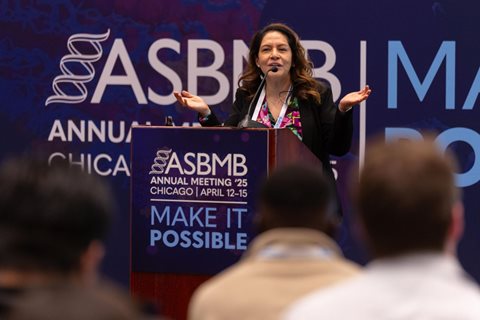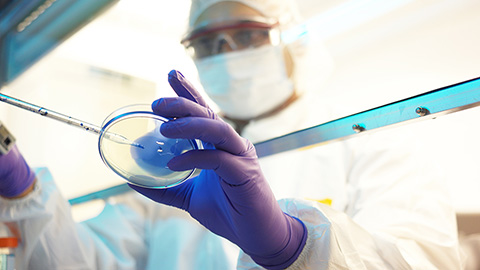Insights on a career at a primarily undergraduate institution
There are a vast number of careers at institutions that variably combine research and teaching. When I was in graduate school, I was taught that the prized jobs I should be working toward were those at doctoral-granting institutions with high research activity — the so-called R1 institutions. These institutions have a lot of grant funding, a lot of research and a lot of graduate students. But they aren’t the only places where you can have a fulfilling and successful academic career in research.
I was lucky: In the Baltimore, Maryland, area, where I went to grad school, I was exposed to a number of primarily undergraduate institutions. PUIs, as they're called, have few to no graduate students in STEM, meaning most research is done by undergrads. There’s also a heavier emphasis on teaching.

To help explain research careers at these institutions, I spoke with John Tansey, a professor of chemistry and the director of the biochemistry and molecular biology program at Otterbein University in Ohio.
Tansey earned his Ph.D. in biochemistry from Wake Forest University, and then went on to be a postdoc at the National Institutes of Health. While there, he taught a class at a nearby community college to get experience, and, when it came time for the next step in his career, he cast a wide net. He applied to many different companies and schools. He ultimately decided to accept a position at Otterbein and has remained there for the past 21 years.
The PUI environment
Tansey said one of the biggest differences between PUIs and large research institutions are their motivations. He said that large research institutions are predominantly working to generate new knowledge and do science in the traditional sense. Whereas at a PUI the primary output isn’t science; it is the students — the undergraduates who go on to become graduate students, premed students or other members of the workforce.
“If I made some great scientific discovery, people on campus here may not get as excited as they would at an R1 institute,” Tansey said. “But when the students do well, that gets people’s attention — it’s a different emphasis that way.”
Tansey teaches undergraduate courses during the school year, and sometimes during the summer, and he runs a research lab. He said he can still do research and ask big scientific questions, but the timelines are different. “It takes longer to do everything,” he said.
Undergraduates turn over faster than graduate students, and they don’t stick around to finish up a project that’s been stalled for months. They tend to be less focused on generating research results than graduate students. Also, there are fewer senior lab members to provide training for new students, so Tansey does a lot of the training himself.
“Teaching and working with students in the classroom and laboratory has, by far, been the greatest aspect of my career,” he said. “We are kind of like coaches. It’s really exciting to see your student’s success.”
Tansey said another benefit of working at a PUI is the flexibility afforded by academia. On top of his traditional lecture classes, he offers specialized seminars that he developed for upper-level students. One is about the science and business of bourbon, co-taught with a professor of business. Tansey focuses on the science (how fermentation works, the health effects of alcohol consumption and other topics). The business professor covers the business of setting up and running a distillery. (Note: if this seminar is ever offered online, I will be signing up immediately). He also can choose how he divides any extra time he has, and has been an active member of the American Society for Biochemistry and Molecular Biology for several years.
Tansey's research is supported by his institution, but external funding is available for PUI researchers. While the traditional R- and K-style NIH grants may not be the best choice, there are others; for example, a colleague of his received funding from the National Science Foundation to acquire a teaching instrument, which can be used both in the classroom and lab.

A little advice
If you’re interested in a career at a PUI, Tansey has a few points of advice. “It’s a hugely rewarding career, but you have to know what you’re getting into,” he said. That means both gaining exposure to teaching prior to applying, either as an adjunct or during graduate school if possible, and also thoroughly researching the PUI to which you are applying.
Tansey said PUIs vary a lot — some faculty members might teach three to four courses a year, but some might teach eight. Some PUIs expect their faculty members to secure external grant funding, and some don’t. Getting a sense of expectations during the job application process is key.
Students who attend the PUI also have an impact on a faculty member's experience. “Everyone’s expectations for undergraduates will likely be flavored by their own undergraduate experience, even if it’s subconscious,” Tansey said. “Remembering that those experiences aren’t universal when approaching a class or students is good practice.” For example, not all students will have the same pre-college prep or exposure to science. Being prepared to accommodate students from all backgrounds is critical to success at a PUI.
On the flip side, Tansey said, when a PUI search committee is looking to hire a new faculty member, they often look for someone who can teach a cohort of classes. Keep in mind that not all of these classes will align with your background. For example, Tansey has a background in biochemistry and teaches that course on top of general chemistry, but he also has taught organic chemistry and molecular genetics. Showing that you can teach a variety of subjects can make you a stronger applicant.
As for salaries, they can range greatly. Tansey said they often start in the $60,000 to $65,000 range, although the institution's location and financial footing will impact this. Most contracts are for 10 months, and extra teaching during the summer can help boost your earning. External grant funding also might supplement salary. It’s a good idea to ask about these options when interviewing.
Lastly, Tansey notes that PUIs are not an easier route to do research. “It’s a different job than working at a large research institution, but it’s not an easier job,” he said. “There are similar aspects: We are all scientists, but our focus and motivations may be different.”
Enjoy reading ASBMB Today?
Become a member to receive the print edition four times a year and the digital edition monthly.
Learn moreFeatured jobs
from the ASBMB career center
Get the latest from ASBMB Today
Enter your email address, and we’ll send you a weekly email with recent articles, interviews and more.
Latest in Careers
Careers highlights or most popular articles

Building the blueprint to block HIV
Wesley Sundquist will present his work on the HIV capsid and revolutionary drug, Lenacapavir, at the ASBMB Annual Meeting, March 7–10, in Maryland.

Upcoming opportunities
Present your research alongside other outstanding scientists. The #ASBMB26 late-breaking abstract deadline is Jan. 15.

Designing life’s building blocks with AI
Tanja Kortemme, a professor at the University of California, San Francisco, will discuss her research using computational biology to engineer proteins at the 2026 ASBMB Annual Meeting.

Upcoming opportunities
#ASBMB26 late-breaking abstract submission opens on December 8. Register by Jan. 15 to get the early rate on our Annual Meeting.

Make your abstract stand out
Ensure your research is impossible to overlook. Get quick, practical reminders for crafting an abstract that attracts readers and helps you build connections at the conference.

Inside industry postdocs
As more Ph.D. scientists look beyond academia, industry postdocs offer a new kind of training, where mentorship meets mission-driven research. Fellows at Pfizer and Genentech share how these programs prepare them to translate discovery into impact.

